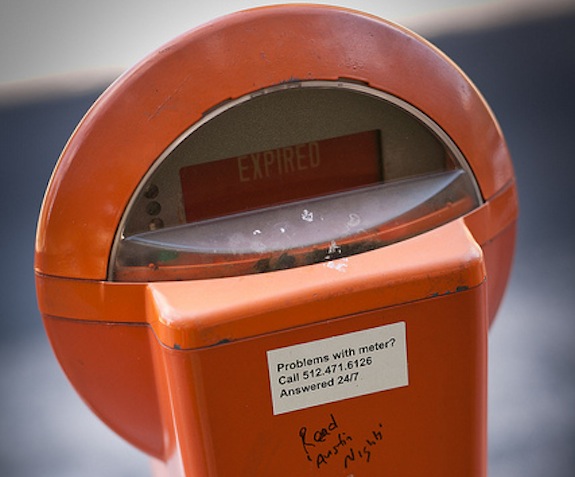Parking Meters, Originally Meant to Keep Traffic Moving, Need an Update
The long history of the parking meter - innocent seeming towers behind much of today’s driving woes

Image: Matt Peoples
Anyone who’s ever driven in a city has probably gotten into some sort of altercation with a parking meter. The little boxes eat money, never show the right time and provide endless frustration for drivers. But that wasn’t the original intention. Collectors Weekly has a long history of the meter, arguing that these innocent-seeming towers are behind many of today’s driving woes:
Contrary to popular belief, the parking meter was originally designed to keep traffic moving and make more spaces available for shoppers, a measure often lauded by local businesses as much as the public who paid their hourly rates. Beginning with the first parking meter, installed in 1935 on the corner of First Street and Robinson Avenue in Oklahoma City, and spreading clear across the United States, the device was hailed as the great solution to our parking woes. Yet decades of poor meter implementation, inane off-street parking requirements, and technological stasis slowly turned our city streets into a driver’s nightmare.
As parking meters became more and more common, Americans came to be more and more car hungry. Providing incentives like “free parking” became a selling point for companies or towns. (Because no one can resist free parking.) The end result: the state of parking today is nothing to boast about. Here’s Collectors Weekly again:
Today, parking covers more of urban America than any other single-use space, yet the vast majority of meters are outdated, coin-only devices, charging a flat-rate during operating hours across all zones. “From the user’s point of view, most American parking meters remain identical to the original 1935 model,” writes Shoup. “You put coins in the meter to buy a specific amount of time, and you risk getting a ticket if you don’t return before your time expires. The main change in 70 years is that few meters now take nickels. In real terms, however, the price of most curb parking hasn’t increased; adjusted for inflation, 5 cents in 1935 was worth 65 cents in 2004, less than the price of parking for an hour at many meters in 2004.” Once praised as the answer to our auto problems, the invention has languished on American sidewalks. (POM, Inc., the descendant of the Magee-Hale company, is still producing standard meter designs, albeit with digital LCD screens and credit card payment modules.)
European cities have adopted modern parking meters, which accept credit cards and actually charge drivers a price based on demand, rather than some arbitrary coin-based amount. So has San Francisco. The San Francisco Examiner writes:
Instead of drawing in reams of revenue for the SFMTA, the SFpark program has actually contributed to a slight loss. The agency expects to receive about $5.5 million less than expected from parking citations this fiscal year, although those losses are offset mostly by an increase of $4.4 million from additional meter revenue. The agency has a total budget of $830 million.
“The obligation of this program from the onset was to achieve the lowest parking prices possible to achieve our goals,” Primus said. “I think we’re proving that.”
And the benefits aren’t just cheaper parking, says Collectors Weekly:
As a result of its meter upgrades, the city was able to pay for street improvements and provide free wi-fi across its central business district, not to mention hiring parking-enforcement officers whose presence has helped reduce crime rates up to 40 percent.
For the sake of city drivers, many hope that old coin parking meters will give way to these new, flexible designs. Others hope that cars will go away all together. But no one is holding their breath for either.
More from Smithsonian.com:
/https://tf-cmsv2-smithsonianmag-media.s3.amazonaws.com/accounts/headshot/Rose-Eveleth-240.jpg)
/https://tf-cmsv2-smithsonianmag-media.s3.amazonaws.com/accounts/headshot/Rose-Eveleth-240.jpg)